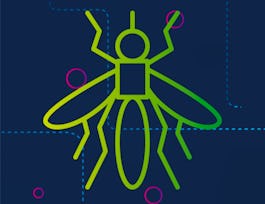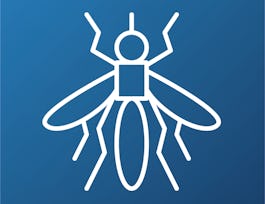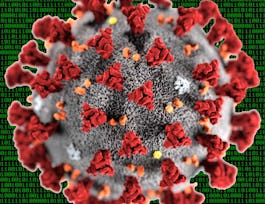This course covers approaches for modelling treatment of infectious disease, as well as for modelling vaccination. Building on the SIR model, you will learn how to incorporate additional compartments to represent the effects of interventions, such the effect of vaccination in reducing susceptibility. You will learn about ‘leaky’ vaccines and how to model them, as well as different types of vaccine and treatment effects. It is important to consider basic relationships between models and data, so, using the basic SIR model you have developed in course 1, you will calibrate this model to epidemic data. Performing such a calibration by hand will help you gain an understanding of how model parameters can be adjusted in order to capture real-world data. Lastly in this course, you will learn about two simple approaches to computer-based model calibration - the least-squares approach and the maximum-likelihood approach; you will perform model calibrations under each of these approaches in R.


Interventions and Calibration
This course is part of Infectious Disease Modelling Specialization
Taught in English
Some content may not be translated

Instructor: Nimalan Arinaminpathy
2,916 already enrolled
Included with 
Course
(52 reviews)
What you'll learn
Identify the relationship between models and real-world epidemiological data
Incorporate treatment or vaccination into an SIR model, accounting for imperfect efficacy, and for different mechanisms of action
Perform simple calibrations of an SIR model against time-series data, selecting parameters to maximise the fit of the model to the data
Recognise two simple approaches to computer-based model calibration and perform model calibrations under each of these approaches in R.
Skills you'll gain
Details to know

Add to your LinkedIn profile
2 quizzes
Course
(52 reviews)
See how employees at top companies are mastering in-demand skills

Build your subject-matter expertise
- Learn new concepts from industry experts
- Gain a foundational understanding of a subject or tool
- Develop job-relevant skills with hands-on projects
- Earn a shareable career certificate


Earn a career certificate
Add this credential to your LinkedIn profile, resume, or CV
Share it on social media and in your performance review

There are 4 modules in this course
Once you have captured the basic dynamics of transmission using simple mathematical models, it is possible to use these models to simulate the impact of different interventions. You will study approaches for modelling treatment of infectious disease, as well as for modelling vaccination. Building on the SIR model, you will learn how to incorporate additional compartments to represent the effects of interventions (for example, the effect of vaccination in reducing susceptibility). You will learn about ‘leaky’ vaccines and how to model them, as well as different types of vaccine and treatment effects.
What's included
5 videos5 readings2 discussion prompts11 ungraded labs
All models answering public health questions first need to be matched, or ‘calibrated’, against real-world data to ensure that model-simulated dynamics are consistent with what is observed. In this module, you will consider basic relationships between models and data. Using the basic SIR model that you've developed so far, you will calibrate this model to epidemic data. Through performing this calibration by hand, you'll gain an understanding of how model parameters can be adjusted so as to order to capture real-world data.
What's included
4 videos1 discussion prompt4 ungraded labs
In practice model calibration for compartmental models is rarely done by hand. Rather, we construct a function that summarises the goodness-of-fit between the model and the data and then use available computer algorithms to maximise this goodness-of-fit. In these next two modules, you will learn about two simple approaches to computer-based model calibration: the least-squares approach and the maximum-likelihood approach. You will perform model calibrations under each of these approaches in R.
What's included
3 videos6 ungraded labs
Please note - learning outcomes are the same across both this and the last module. In practice, model calibration for compartmental models is rarely done by hand. Rather, we construct a function that summarises the goodness-of-fit between the model and the data and then use available computer algorithms to maximise this goodness-of-fit. In these two modules, you'll learn about two simple approaches to computer-based model calibration: the least-squares approach, and the maximum-likelihood approach. You will perform model calibrations under each of these approaches in R.
What's included
4 videos1 reading2 quizzes4 ungraded labs
Instructor

Offered by
Recommended if you're interested in Public Health

Imperial College London

Imperial College London

Imperial College London

University of California San Diego
Prepare for a degree
Taking this course by Imperial College London may provide you with a preview of the topics, materials and instructors in a related degree program which can help you decide if the topic or university is right for you.
Why people choose Coursera for their career




Learner reviews
Showing 3 of 52
52 reviews
- 5 stars
76.92%
- 4 stars
17.30%
- 3 stars
1.92%
- 2 stars
3.84%
- 1 star
0%
New to Public Health? Start here.

Open new doors with Coursera Plus
Unlimited access to 7,000+ world-class courses, hands-on projects, and job-ready certificate programs - all included in your subscription
Advance your career with an online degree
Earn a degree from world-class universities - 100% online
Join over 3,400 global companies that choose Coursera for Business
Upskill your employees to excel in the digital economy
Frequently asked questions
Access to lectures and assignments depends on your type of enrollment. If you take a course in audit mode, you will be able to see most course materials for free. To access graded assignments and to earn a Certificate, you will need to purchase the Certificate experience, during or after your audit. If you don't see the audit option:
The course may not offer an audit option. You can try a Free Trial instead, or apply for Financial Aid.
The course may offer 'Full Course, No Certificate' instead. This option lets you see all course materials, submit required assessments, and get a final grade. This also means that you will not be able to purchase a Certificate experience.
When you enroll in the course, you get access to all of the courses in the Specialization, and you earn a certificate when you complete the work. Your electronic Certificate will be added to your Accomplishments page - from there, you can print your Certificate or add it to your LinkedIn profile. If you only want to read and view the course content, you can audit the course for free.
If you subscribed, you get a 7-day free trial during which you can cancel at no penalty. After that, we don’t give refunds, but you can cancel your subscription at any time. See our full refund policy.

